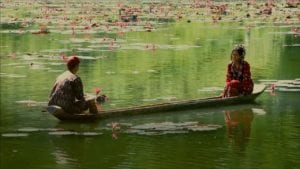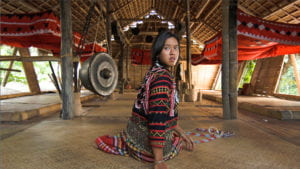2014 | 1h 25min | Written and directed by Ida del Mundo
 “Inspiring. A film with an epic, dreamlike quality.”
“Inspiring. A film with an epic, dreamlike quality.”
— Zig Marasigan, film critic/screenwriter
“The Find of the Season: Ida del Mundo as a screenwriter and director in a stunning debut in K’na, the Dreamweaver. Lyrical, poetic and almost mythical in its unfolding of a t’nalak weaver with a rediscovered Mara Lopez in the title role.”
—Jose Javier Reyes, writer/director
Synopsis:
When K’na, a young T’boli woman, becomes a dreamweaver, she has the chance to weave together her village’s warring clans, and in the process faces a choice between this dream and her personal happiness.
Cast:
Mara Lopez (K’na), RK Bagatsing (Silaw), Erlinda Villalobos (Be Lamfey), Alex Medina (Kagis), Nonie Buencamino (Lobong Ditan), Bembol Roco (North Chieftain)
Producers: TBA Productions and Cinemalaya
Awards:
| Cinemalaya Film Festival | Special Jury Prize, Best Production Design |
| Native Spirit Film Festival, London | Opening Night film |
| Toronto Female Eye Film Festival | Best of Show |
About the Director
Ida Anita del Mundo, an only child, was born in Iowa City when her father was on a writing fellowship at the Iowa University. She has an AB in Literature and MFA in Creative Writing from De La Salle University-Manila. She now teaches Literature and Art Appreciation at De La Salle University and Screenwriting at the College of Saint Benilde. She was a staff writer for the magazine Starweek and a violinist for the MSO (Manila Symphony Orchestra). Her follow-up film after K’na, the Dreamweaver was An Orchestra in Search of a Home, a documentary about the MSO.
About the Film
 K’NA, THE DREAMWEAVER is set in the world of the T’bolis, one of some twenty indigenous ethnic groups in the island of Mindanao that have remained un-Islamicized and un-Christianized. These groups have managed to retain their core traditions and beliefs through centuries of incursions, attacks, and pressures from invaders, religious proselytizers, slave raiders, foreign colonizers, rapacious loggers, and eager settlers. Huge challenges remain for these groups, most of whom have been pushed through time by new arrivals, from fertile ancestral plains to the highlands into marginalized poverty and isolation. Yet it is this remoteness that has somehow helped them to preserve their ancestral languages and traditions.
K’NA, THE DREAMWEAVER is set in the world of the T’bolis, one of some twenty indigenous ethnic groups in the island of Mindanao that have remained un-Islamicized and un-Christianized. These groups have managed to retain their core traditions and beliefs through centuries of incursions, attacks, and pressures from invaders, religious proselytizers, slave raiders, foreign colonizers, rapacious loggers, and eager settlers. Huge challenges remain for these groups, most of whom have been pushed through time by new arrivals, from fertile ancestral plains to the highlands into marginalized poverty and isolation. Yet it is this remoteness that has somehow helped them to preserve their ancestral languages and traditions.
There is at least a ray of hope in a growing consciousness among younger mindful Filipinos about the vital respect that these abiding cultures and languages merit and a spreading appreciation of their unique role in the national identity. Facing age-old injustices and forces prone to running non-dominant cultures into extinction, initiatives and organizations have sprung from both within and outside these indigenous groups for greater safeguards and support, however uphill the battle may be, for their traditions and livelihoods.
The T’bolis, who live in the mountains around three vast and magnificent lakes, are among the most colorful and artistic of these indigenous groups. They dwell in hamlets of four or five houses and believe that all beings, animate or inanimate, are suffused by spirits. They have their distinct pantheon of gods and goddesses handed down through generations and celebrated in an epic that takes the better part of a day and night to sing.
The T’bolis are known for the t’nalak, cloth woven from abaca by master weavers, called dreamweavers, as it’s believed that the designs are given to them by the ancestors and gods through dreams. The most well-known practitioner of the art is a T’boli princess, the late Lang Dulay, who drew from a repertoire of over a hundred t’nalak designs collected over a lifetime of dreams, established a weaving center to counter the insidious wages of rampant commercialization and tourist kitsch, and was conferred the Philippines’ rare National Living Treasure designation. The t’nalak gained some international attention when Catriona Gray, after travelling to the T’boli homeland to ask permission and advice on the t’nalak, paraded in the eye-catching fabric at press events at the Miss Universe pageant where she barged into Philippine mythology wearing a tumescent pearl crown.
Ida del Mundo’s first encounter with the T’bolis was at a t’nalak festival that the magazine Starweek sent her to cover. At one point during the sojourn, her group decided to hike down a mountain to see the Kofnit cave with its subterranean river and jostling throngs of swiftlets and bats. Halfway down the steep mountain, rain started pouring and they only managed to reach the cave and the wakening bats hours later than scheduled. (“Keep your mouth shut in case some droppings plop down from the ceiling” is the usual admonition.) It became too dark and dangerous to hike up the mountain to get back to the T’boli School of Living Tradition where they were billeted. After a trek with only some flashlights and headlamps to alert them of sharp obstacles and fatal ravines, they came upon a hamlet consisting of four or five huts without electricity. Not only was the exhausted group welcomed with warmth, their hosts started singing and dancing for them. Wrote del Mundo, “From the near-death experiences climbing in the dark to the warmth of the community where we stayed the night – that is what changed and is continuing to change my life in so many ways.” She found herself forever captured in a T’boli dream.
Inspired by films of Zhang Yimou that were both epic and intimate, del Mundo had been wanting to write a love story but it remained a story in search of a setting. She finally found that setting during the trip. An only child, she had grown up in a household steeped in film culture. Her dad, Doy del Mundo was an acclaimed writer and director. One of his most famous works was the screenplay of Lino Brocka’s Manila: In the Claws of Light, regularly voted in critics’ polls as the greatest Filipino film of all time. (It’s the first film from the Philippines that has entered the Criterion galaxy of art house classics.) At the first annual Cinemalaya Film Festival in 2005, Doy won the top award for Pepot Superstar, a film that he wrote and directed.
Cinemalaya went on to establish itself as the most important indie festival in the country. It was from the beginning a competitive program where sequence treatments in the hundreds are submitted by aspirants in a blind process. As an inexperienced filmmaker, Ida submitted to the New Breed category which chooses 10 finalists a year. (There were 167 entries for the category that year.) The chosen finalists are provided seed money by Cinemalaya and the prestige aids them in finding additional funding from independent producers or rich people wanting to get involved in the glitter and glamour, wantonly deceptive as it often turns out, of making movies.
Cinemalaya has played a major part in the contemporary renaissance of indie filmmaking that is often called the Third Golden Age of Philippine Cinema. It has been so successful at revealing new talent and supporting independent visions (as opposed to the usually mind-numbing romcoms, fantasies, and action movies churned out by the major studios) that a number of annual indie jousts based on the Cinemalaya model have sprouted in its wake, among them Cinema One, CineFilipino, the QCinema, and Sinag Maynila. The discovery of talent from this proliferation of festivals has been tremendous. Unfortunately, it remains catch as catch can when it comes to marketing. A film may amaze and coruscate in the light of a festival only to disappear into some ravenous black hole unless it’s picked up for distribution by a major studio or is invited to some foreign festival to flirt with a brief and distant resurrection.
When del Mundo submitted her sequence treatment to Cinemalaya, she had no plans to direct it, as she had never as much done even a short. Her thing at that time was the written word and she proposed as part of the package an experienced female director. However, the screening committee, headed by the celebrated actress/director Laurice Guillen, wanted to ensure that the finished film follow the vision that del Mundo presented and they elbowed her into directing the film herself. With the project’s intriguing seal as a Cinemalaya finalist, a common friend connected del Mundo to businessmen Fernando Ortigas and Ed Rocha who were envisioning film production as a way to leave a cultural legacy for the country. K’NA, THE DREAMWEAVER became their first production.
Del Mundo wrote the screenplay in English and had it translated to the T’boli language. For the leading parts, she chose professional film actors based in Manila, including Mara Lopez for the leading role of K’na and RK Bagatsing for her lover Silaw. The month before the shooting, the actors learned the T’boli language, a forbidding task even if one didn’t aim to emote or grunt or intonate in it, as it was frightfully distinct from any other languages that, awake or asleep, they had ever encountered. Eventually, the entire cast would comprise of these actors and local T’bolis for the supporting roles.
Shooting began on an April 1 at the T’boli’s magnificent Lake Sebu, with Ida’s father Doy taking on the role of line producer and her mother Dreena as volunteer den mother for cast and crew and interim slave for daughter. Most of the leading members of the crew were female, including the distinguished cinematographer Lee Briones (herself a student of Doy in film school). Quipped the first-time director: “Perhaps it was an inauspicious day to start, April Fool’s Day, but what more are dreamers – and filmmakers – but fools? Cue ‘The Impossible Dream’ as we embarked on what at times has seemed like the Quixotic adventure that is indie filmmaking.” In the scrappy and resourceful way that has come to characterize Pinoy indie filmmaking, the shoot, all on location in that remote and rugged terrain, took a mere two weeks.
Del Mundo went against the current grain of indie filmmaking by creating a film that is more of a timeless fable or legend than a work of social realism (something that made a number of critics rise up in arms). While remaining very specific on the T’boli cultural traditions, she wanted to create a paradigm, “a new Filipino legend,” as she termed it, of honoring the Philippine national heritage not just of beautiful things but also the heritage of quiet sacrifices. Visually, the film has the minimalist aesthetics found in Chinese or Japanese art – where a few huts in the mist connote an entire village, a sprinkling of warriors a decisive battle, some passing remarks an ancestral missive.
The vision, that the Cinemalaya panel wanted del Mundo to capture, resonated, however the compromises forced by the usual small indie film budget. K’NA, THE DREAMWEAVER went on to win the Special Jury Prize at Cinemalaya and the top award at the Toronto Female Eye Film Festival before it was invited to open the Native Spirit Film Festival in London. It has become a popular choice for celebrating the Philippines’ National Indigenous People’s Month and several embassies have shown it to demonstrate the diversity of Philippine culture or to just mount a happening for expatriates and OFW’s longing for their homeland.
For del Mundo, the most priceless and memorable presentation of the film was the one held at an improvised free screening hall by Lake Sebu, attended by some 5,000 T’bolis, many of whom had never been inside a movie house. At the end of the screening, some of the now modernizing young T’bolis spoke of how the experience made them proud to be T’boli (well aware of how marginalized their culture was through much of its history) and how it had made them realize the value and beauty of embracing their identity.
—Gil Quito
Behind-the-Scenes
 Watch behind-the-scenes interviews with the director from:
Watch behind-the-scenes interviews with the director from:
De La Salle University:
Singapore Art Museum
Watch an interview from News Café with the director and lead actress Mara Lopez:
Watch a short clip of the audition by Mara Lopez for the film’s lead role:
Stream the Movie
In coordination with its producer TBA Studios, Sulo has ensured that the K’na, the Dreamweaver will be available on the TBA Studios’ YouTube Channel from April 23-29.